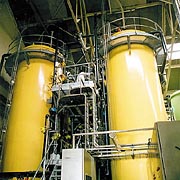
Ion exchange is a physical/chemical process in which ions, held electrostatically on the surface of a solid, are exchanged for ions of similar charge in a solution. It removes ions from the aqueous phase by the exchange of cations or anions between the contaminants and the exchange medium.
The medium used for ion exchange typically is a resin made from synthetic organic materials, inorganic materials or natural polymeric materials that contain ionic functional groups to which exchangeable ions are attached. Four types of ion exchange media have been used – strong and weak acids and strong and weak bases. Strong and weak acid resins exchange cations, while strong and weak base resins exchange anions. Because dissolved arsenic usually is in an anionic form, and weak base resins tend to be effective over a smaller pH range, strong base resins typically are used for arsenic treatment.
Resins also may be categorized by the ion that is exchanged with the one in solution. For example, resins that exchange a chloride ion are referred to as chloride-form resins. Another way of categorizing resins is by the type of ion in solution that the resin preferentially exchanges. For example, resins that preferentially exchange sulfate ions are referred to as sulfate-selective. Both sulfate-selective and nitrate-selective resins have been used for arsenic removal.
The resin usually is packed into a column, and as contaminated water is passed through the column, contaminant ions are exchanged for other ions such as chloride or hydroxide in the resin. Ion exchange often is preceded by treatments such as filtration and oil-water separation to remove organics, suspended solids and other contaminants that can foul the resins and reduce their effectiveness.
Ion exchange resins must be regenerated periodically to remove the adsorbed contaminants and replenish the exchanged ions. Regeneration of a resin occurs in three steps:
- backwashing
- regeneration with a solution of ions
- final rinsing to remove regenerating solution
The regeneration process results in a backwash solution, a waste regeneration solution and a waste rinse water. The volume of spent regeneration solution ranges from 1.5 percent to 10 percent of the treated water volume, depending on the feed water quality and type of ion exchange unit. The number of ion exchange bed volumes that can be treated before regeneration is needed can range from 300 to 60,000. The regenerating solution can be used up to 25 times before treatment or disposal is required. The final rinsing step usually requires only a few bed volumes of water.
Ion exchange can be operated using multiple beds in series to reduce the need for bed regeneration. Beds at the beginning of the series will require regeneration first, and fresh beds can be added at the end of the series. Multiple beds also can allow for continuous operation because some of the beds can be regenerated while others continue to treat water. Ion exchange beds typically are operated as a fixed bed, in which the water to be treated is passed over an immobile ion exchange resin. One variation of this approach is to operate the bed in a non-fixed, countercurrent fashion in which water is applied in one direction – usually downward – while spent ion exchange resin is removed from the top of the bed. Regenerated resin is added to the bottom of the bed. This method can reduce the frequency of resin regeneration.
For ion exchange systems using chloride-form resins, the treated water could contain increased levels of chloride ions and, as a result, be corrosive. Chlorides also can increase the redox potential of iron, thus increasing the potential for water discoloration if the iron is oxidized. The ion exchange process also can lower the pH of treated waters.
For ion exchange resins used to remove arsenic from water, the spent regenerating solution might contain a high concentration of arsenic and other sorbed contaminants and could be corrosive. Spent resin is produced when the resin no longer can be regenerated. The spent resin mats require treatment prior to reuse or disposal.
Modifications to ion exchange treatment systems that can help reduce the effluent concentrations of arsenic to meet the revised maximum contaminant level of 0.10 mg/L include:
- addition of an ion exchange bed
- use of a different ion exchange resin
- more frequent regeneration or replacement of ion exchange media
- decrease in the flow rate of water treated
- addition of another technology to the treatment train, such as membrane filtration
However, these modifications could increase costs for purchasing additional or more expensive resin, more frequent regeneration of resin and increased amounts of treatment residuals. For example, more frequent regeneration is likely to generate greater volumes of spent regeneration fluid.
Report Abusive Comment